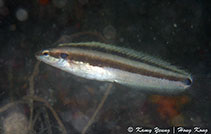| Family: |
Blenniidae (Combtooth blennies), subfamily: Blenniinae |
| Max. size: |
7.65 cm SL (male/unsexed) |
| Environment: |
demersal; marine; depth range 8 - 45 m |
| Distribution: |
Northern West Pacific: Hong-kong, Taiwan , southern Japan. |
| Diagnosis: |
Dorsal spines (total): 12-12; Dorsal soft rays (total): 21-21; Anal spines: 2-2; Anal soft rays: 21-21. Head with well-developed cirri; mandibular cirrus multifold; preopercular canal pores with cirri. Supratemporal canal with 3 pores. A pale-blue, broad stripe extending from snout to base of causal fin. Operculum and caudal fin base with a dark blue spot. |
| Biology: |
Oviparous. Eggs are demersal and adhesive (Ref. 205), and are attached to the substrate via a filamentous, adhesive pad or pedestal (Ref. 94114). Larvae are planktonic, often found in shallow, coastal waters (Ref. 94114). Minimum depth from Ref. 58018. |
| IUCN Red List Status: |
Least Concern (LC); Date assessed: 25 March 2009 Ref. (130435)
|
| Threat to humans: |
harmless |
Source and more info: www.fishbase.org. For personal, classroom, and other internal use only. Not for publication.
